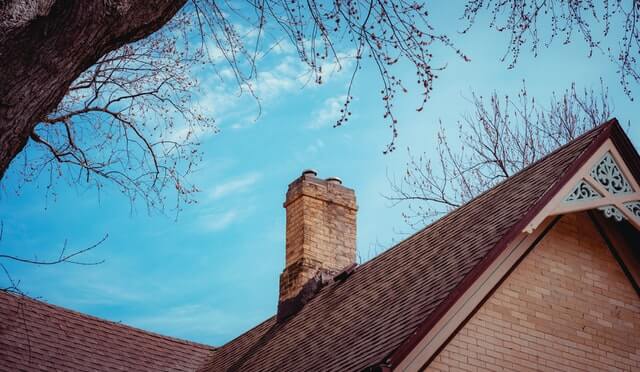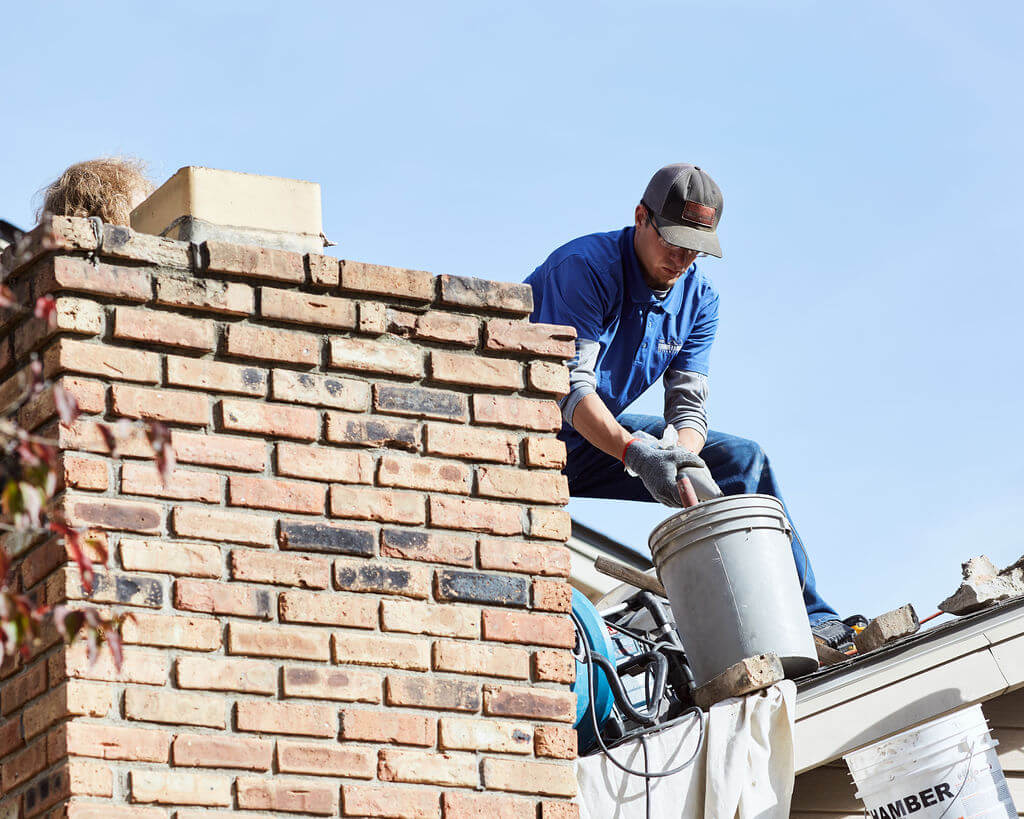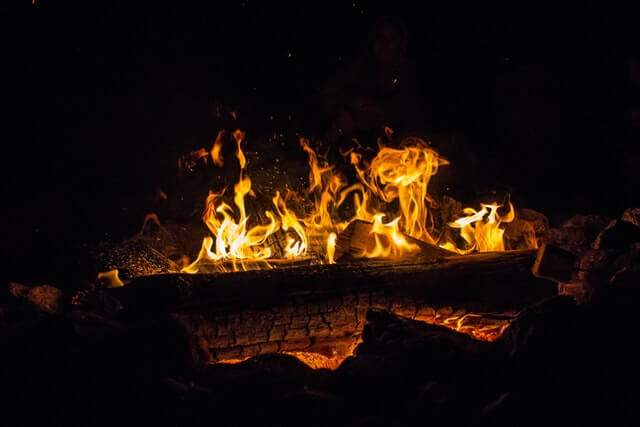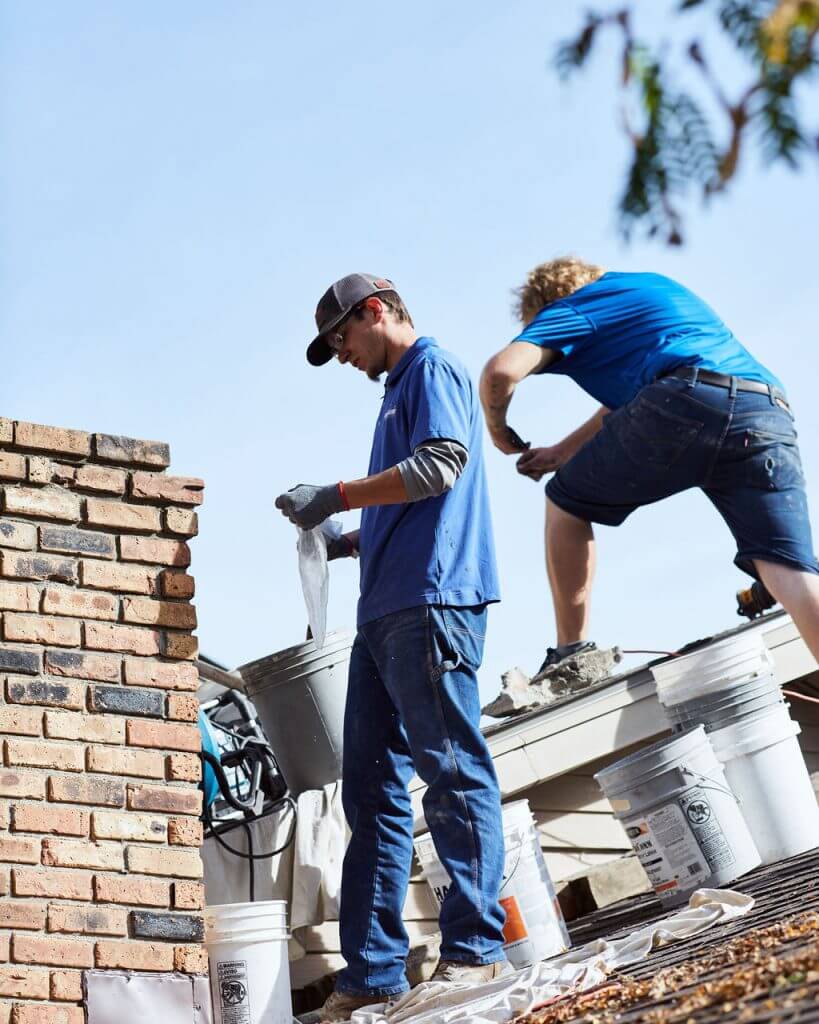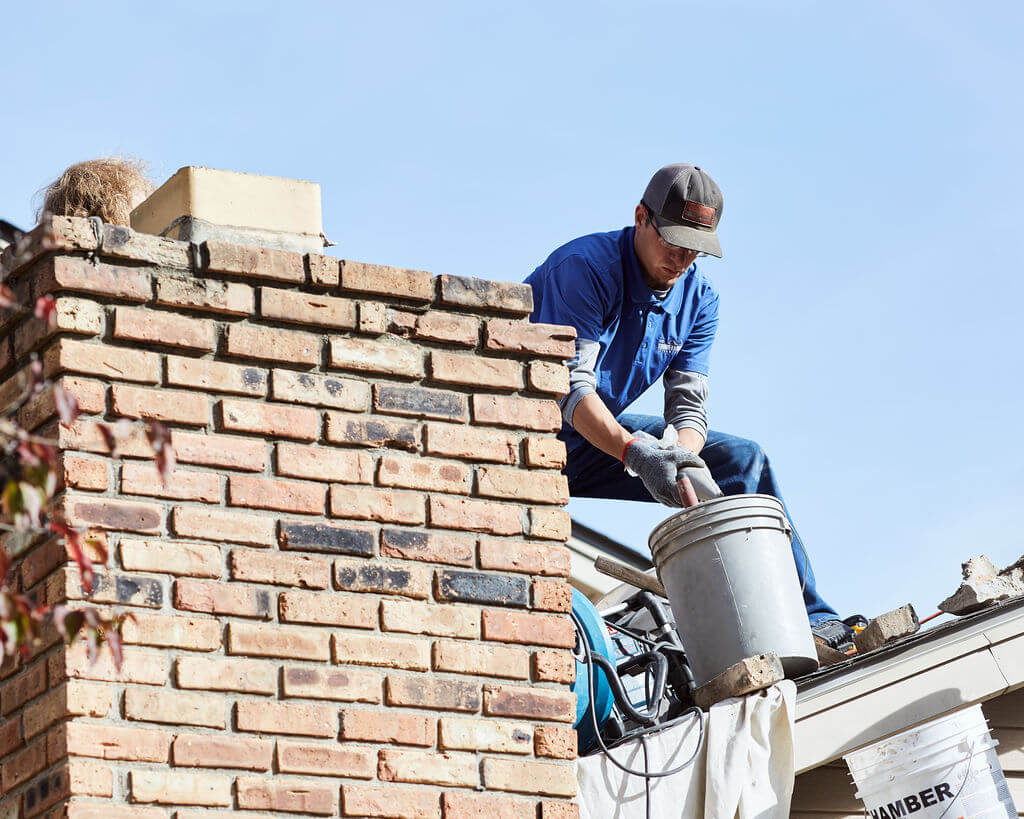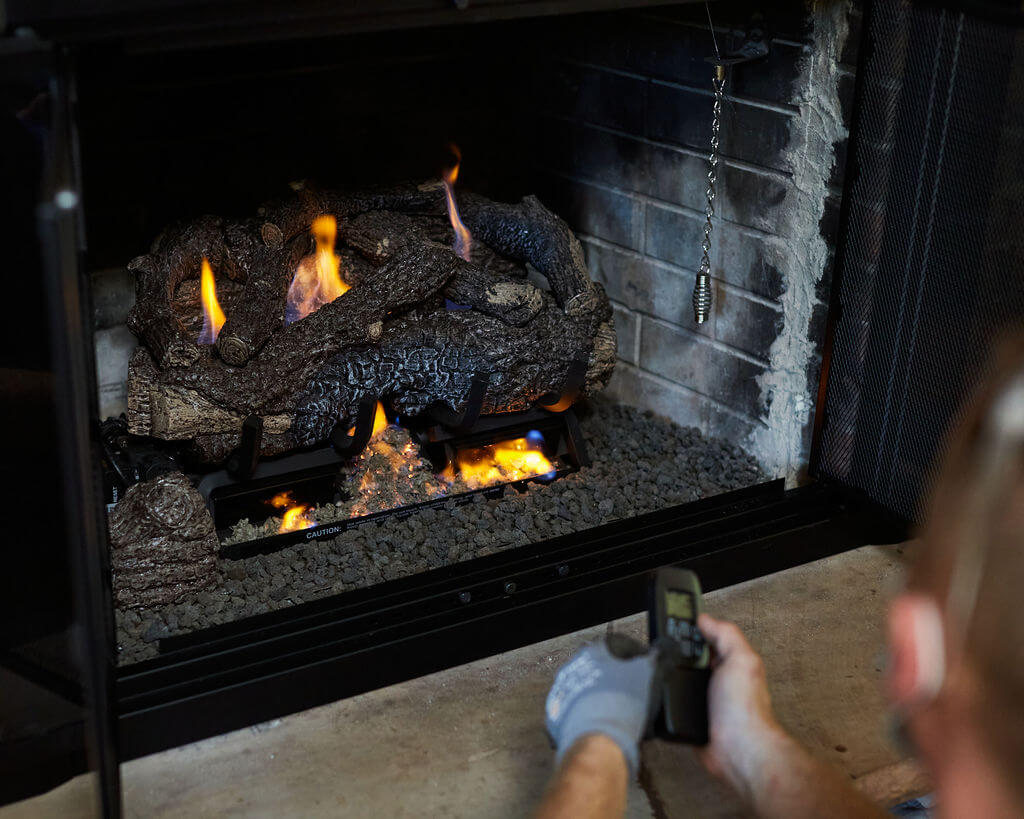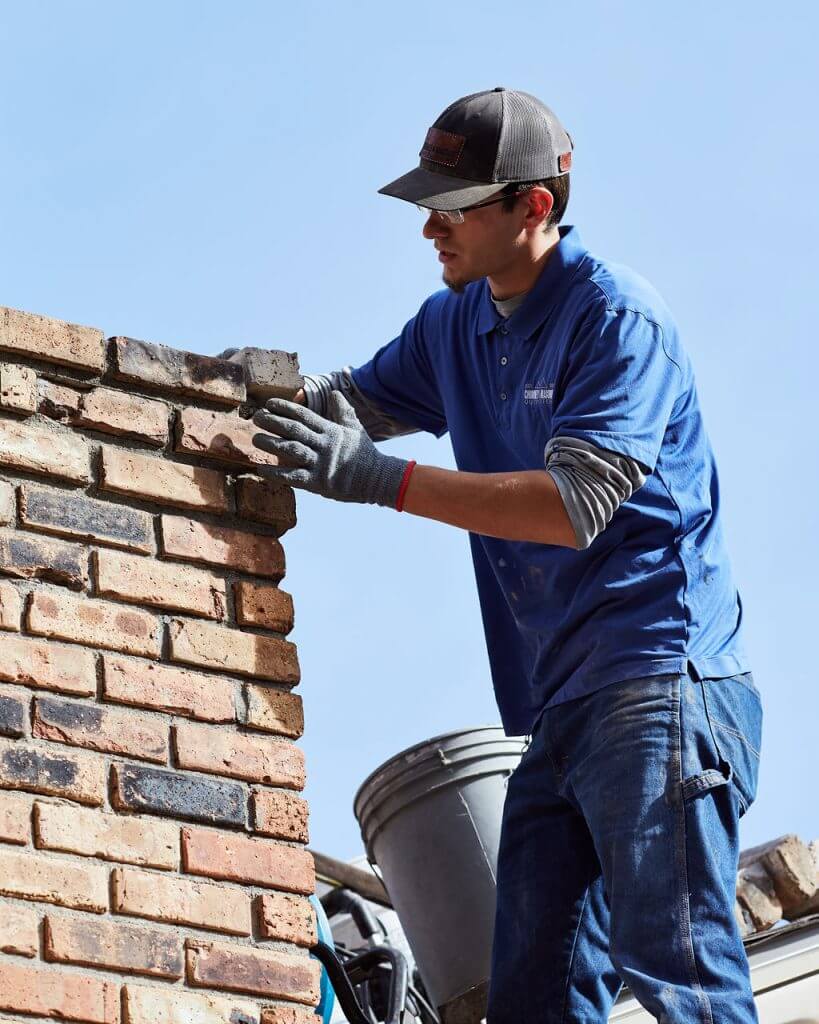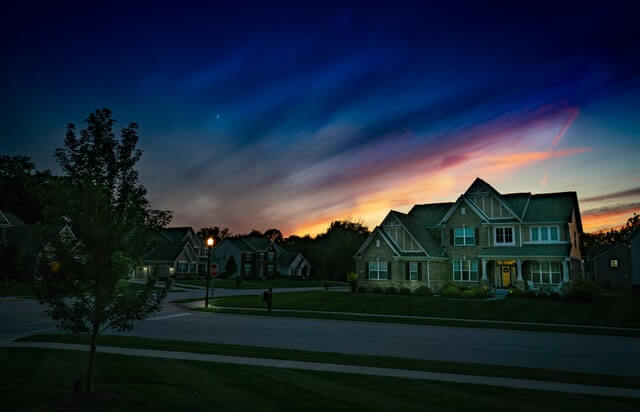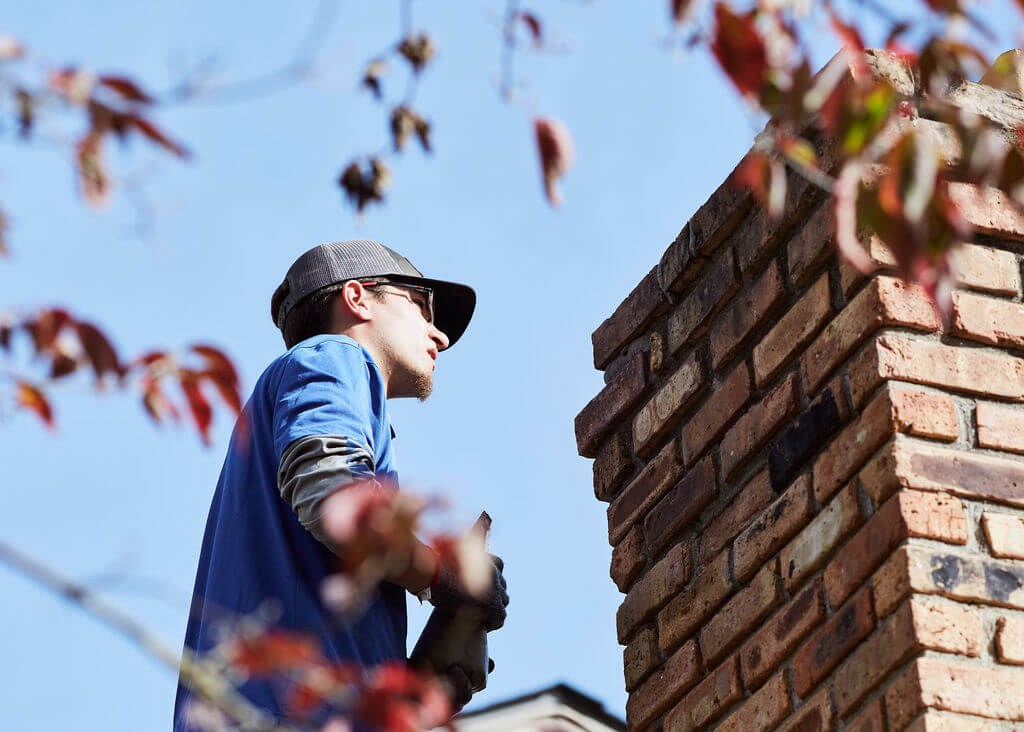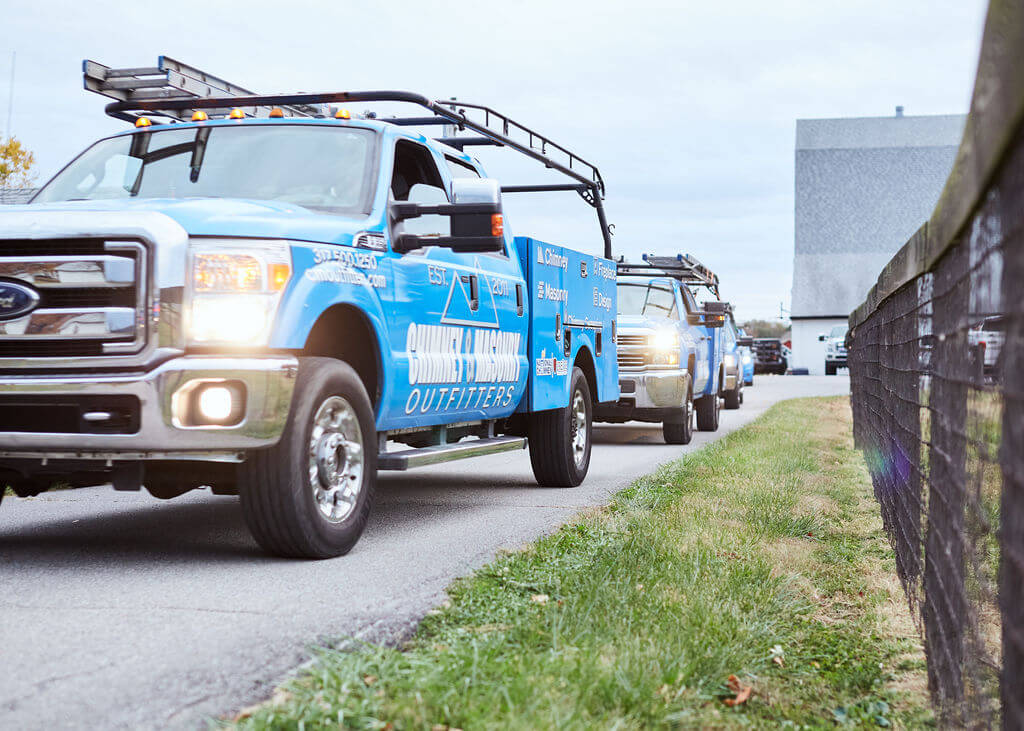New Homeowner’s Guide to an Indianapolis Chimney Sweep
New homeowner’s guide to an Indianapolis chimney sweep. Congratulations on becoming a homeowner! Owning a home can be an empowering moment in a person’s life, but it can also be overwhelming, especially for first-time homeowners. And if there’s a fireplace in your new home, making sure your chimney is clean should be at the top of your to-do list.
There’s nothing homier than snuggling up to a fire on a cold winter’s night. However, if you do not check your chimney first to see if it’s safe to light a fire, you could cause an out-of-control chimney blaze. With a proper inspection and cleaning by a certified professional, you can prevent house fires and other damage to your new home.
What is a Chimney Sweep?
Cleaning a chimney can be an arduous task, resulting in a big mess if done incorrectly. You could even end up starting a house fire. Hiring a professional chimney sweep can make all the difference in helping you maintain your chimney to avoid fires and other disasters.
Chimney sweeps have extensive training in unblocking your chimney, cleaning smoke ducts and flue pipes, and providing suggestions about correct burning methods and proper chimney maintenance techniques. They also have the knowledge and tools to prepare the area before the job and clean up after completion.
The Chimney Sweep Process
Once you schedule your chimney cleaning appointment, you can expect the following:
- The chimney sweep will thoroughly examine and prep the area by laying down cloth or plastic to shield your home and possessions from any mess.
- Using protective gear and tools like heavy metal bristled brushes and long rods, the sweep will remove any debris along your chimney walls and blockages inside the chimney.
- Some professionals start with cleaning the flue and work their way up, while others may begin on the roof and sweep their way down the chimney.
- Depending on the prep work and the condition of your chimney, the whole process could take an hour.
If your chimney requires deeper cleaning from soot or the toxic creosote glaze that forms from lighting the fireplace, the chimney sweep may eradicate it with a chemical treatment. Sweeps may also have the task of safely removing any animals or pests that have made a home in your chimney.
And if your chimney needs minor repairs, such as replacing a chimney camp or liner, the chimney sweep may handle those issues on the same day or schedule the repairs for another time. Last, you will receive any recommendations for the next steps in your chimney maintenance routine.
Reasons to Get a Chimney Sweep
While you can attempt to clean the chimney yourself, you may not have the tools or knowledge to address hazardous problems. If you want to avoid significant damage to your home and save money in the long run, it’s best to hire a professional. We recommend choosing a CSIA-certified chimney sweep who can use their expertise and equipment to get the job done safely and efficiently.
In addition, a professional chimney sweep will provide:
- Fast and clean service;
- Comprehensive inspection and evaluation of your chimney and all of its components;
- Careful extraction of any animals and other blockages; and
- Repairs or replacements of the cap or liner if necessary.
How Often Do I Need a Chimney Sweep?
Based on two leading fire safety and protection experts, homeowners should consider cleaning their chimney at least once a year. Whether you have a wood-burning or gas fireplace, the National Fire Protection Association (NFPA) recommendation is to inspect and clean your chimney, vents, fireplaces, and any solid fuel-burning appliances annually. While the other expert, the Chimney Safety Institute of America (CSIA), advises homeowners to have their chimneys swept when 1/8" of creosote or soot accumulates inside the liner.
Also, if you are hiring a professional, the spring may be the best time to arrange an inspection and cleaning in preparation for use during the colder months.
What to Look for in an Indianapolis Chimney Sweep
Now that you're interested in using a chimney sweep before you book an appointment, here are three factors to consider:
- The most important thing is to check a chimney sweep's qualifications and experience. Even though certifications are not required for chimney sweeping in Indiana, a professional should hold a certificate from Chimney Sweep Institute of America to show they have basic knowledge of proper chimney use, maintenance, and repair. It also helps to know if the chimney sweep is a member of the National Chimney Sweep Guild (NCSG). With an NCSG membership, the provider has access to the latest, cutting-edge technology to produce the best service to the customer.
- The next thing you should look into is whether the chimney sweep company is insured and what their coverage includes. This information is essential to guarantee you have protection in case there are any potential accidents or injuries.
- Finally, it would help if you research any reviews about the company. Testimonials from previous customers can attest to the chimney sweep's professionalism and performance.
Your Brick + Ember Outfitters are Here to Help!
Our team of professionals at Brick + Ember Outfitters has the credentials and experience to provide you with the chimney service and support you need to protect your home from a fire. In our initial assessment, we make sure to notify you immediately if something doesn't look normal. Then we follow up with a more extensive inspection and report back with our considerations for any work or possible repairs.
For a thorough chimney sweep with camera inspection, give us a call at 317-500-1250 today. We are here to ensure your safety and peace of mind whenever you use your fireplace.
What Does a Masonry Contractor Do?
What does a masonry repair Contractor Do? Brick, stone, and concrete are common materials used in a variety of homes.
If your home has any of these materials, including a chimney, then you may have heard of masonry work before. You may have even been advised to hire a masonry contractor for maintenance and repairs.
But what exactly is a mason? And what does a mason contractor do?
Is masonry repair something you can handle on your own?
Today, we’ll take a deep dive into these key questions and look closer at what a mason does.
The Job of a Mason
In essence, masons work with brick, stone, and concrete. They work with these materials for a wide array of structures, including chimneys, patios, retaining walls, and entire buildings. They are experts with the materials and processes of masonry and can assist with anything from masonry repair to design and construction.
The three masonry specialties are stone, brick, and concrete. Some masonry contractors specialize in one material, but most modern masons have the necessary expertise to work with all three.
What do Masons Do?
There is a wide variety of tasks that a professional mason will handle. They may work on aesthetic structures or weight-bearing ones. Commonly, their projects include chimneys, patios, walls, and siding.
What masons do for these structures depends on the condition of the masonry. One of the most common masonry repairs is fixing cracks. Cracks are not only unsightly, but they can allow water in and lead to further damage.
Masons may also repoint masonry, which involves replacing mortar. Cracked, crumbling mortar compromises the durability of the structure. Replacing it improves the stability and appearance of masonry.
Another common masonry repair is to rebuild the structure. When damage is bad enough, a simple repair cannot restore it. In these cases, the mason rebuilds some or all of the structure. Proper maintenance and timely repairs can prevent the need for a rebuild. However, in many older homes, this process is necessary.
Do I Need a Professional Mason?
Many homeowners wonder if they can handle masonry repair on their own. While it may be possible to perform some minor repairs, DIY masonry is generally a bad idea. Tutorials online may make repairs seem a lot more simple than they actually are.
Quality matters for masonry work, especially for weight-bearing structures. The truth is that attempting DIY repair puts your home at risk for further damage in the long run.
If you need masonry repairs or installation, then it’s best to consult a professional mason. Here are the top reasons to hire a masonry expert:
- Save time. Professional masons are experts in their field. Thus, they can perform the work more efficiently than an inexperienced person.
- Avoid costly mistakes. If you attempt your own repair and then realize it’s unsuccessful, you may still have to hire a mason, after you already wasted money and time on supplies. There’s also a chance you could cause even more damage.
- Access to supplies and equipment. Many people underestimate the tools and equipment used in masonry. If you try your own repair, you may have to spend a lot of money just to get the necessary supplies. When you hire a mason, they already have the tools they need to get the job done right.
- Beautiful results. Professional masonry repairs and installation enhance the appearance of your home. They leverage their experience to create beautiful end results!
How to Hire a Mason
Do you have chipped or crack brickwork? A chimney in disarray? If you have masonry throughout your home that needs work, then you need to hire a mason. Of course, you want to ensure you find a quality, trustworthy mason. Here are some helpful tips:
- Ask for written estimates from three or more masons. Price should not be the only factor, but you want to ensure that you are paying a fair amount.
- Look for experience. You need a mason with experience with structures like yours. Keep in mind, different masons may have different specialties. Make sure the specialties and experience align with what you need.
- Review feedback. Trustworthy masons can provide you with references from clients. They should also have a strong reputation online.
Professional Masonry Repair with the Brick + Ember Outfitters
For masonry repair, you can count on, look no further than the Brick + Ember Outfitters. Our experienced contractors have helped hundreds of homeowners with a wide variety of masonry needs. We provide personalized quotes for each and every project. To learn more about our masonry services and how we can help you, contact us today!
Gas Fireplace Service Indianapolis
Gas fireplace service Indianapolis. As the weather begins to transition from hot summer months to crisp fall and you spot the first leaves as they turn from green to red and gold, you’ll likely find yourself thinking ahead to winter preparedness.
Should you order a sun lamp for those cloudy Indianapolis winter days? Do you have a winter kit in case snow or stormy weather keeps you in place for a while? At home, you should be considering not just your weatherproofing, but also the care of your chimney and fireplace.
With the ease of access and fuel efficiency offered by gas fireplaces compared to their older wood-burning counterparts, it’s no surprise they outpace traditional fireplaces in terms of sales.
No fireplace comes without maintenance needs, though, and gas fireplaces have their own unique needs. With the investment of installing a gas fireplace in the first place, regular maintenance will protect your fireplace and ensure you can use it for years to come.
Why Does it Need Service?
Gas fireplaces burn cleaner than wood-burning fireplaces and do not cause smoke or the collection of ash in your chimney, but they still require check-ups at least annually to ensure all their elements are functional, undamaged, and ready for use. This is especially important leading into our fall and winter seasons, when chances are you’re likely to give your fireplace heavy use and transportation can be limited by weather.
Cleaning your fireplace without professional experience working with natural gas is a risk, which is why we recommend utilizing a qualified technician. Damaging a natural gas line would bring unnecessary risk to you and your household, and can even impact your wider community.
What Does Gas Fireplace Service Include?
Inspection
The technician will review the fireplace, chimney, and surrounding portions of the house to make sure they are installed securely and do not have visible signs of wear. If you have a venting gas fireplace, we will make sure any fumes are being redirected out of the home properly so you can rest assured while heating your living room or master bedroom on chilly fall and winter days. If there is any visible collection of condensation or water, this can indicate a leak in the chimney, in which case the source should be identified as quickly as possible and resolved to prevent damage to the home or further compromising of the fireplace system.
The ceramic logs in the fireplace and doors to the fireplace will also need to be checked for cracks or, in the case of the door’s unique sealing edges, leaks. If these are found, the logs can be replaced and the doors re-sealed or replaced if needed. After ensuring they are cool enough, we will take your ceramic logs outside to clean any soot from them to reduce the risk of buildup and make sure they look as charming as when they were first installed.
Test the Gas Line and Ignition
Your favorite quality of life elements of your gas fireplace--the easy ignition, simple control of the flow of gas and strength of fire, and discreet gas line--all need to be regularly reviewed for utmost safety and functionality. They will also clean in and around the decorative logs to ensure proper flow and management of the natural gas in your fireplace, and vacuum potential debris from the back and sides of the fireplace, including pet hair and dust. Regularly cleaning out debris is one way to ensure the only thing burning in your fireplace is smokeless natural gas.
Check Your CO2 Detectors
The CDC reports higher rates of unintentional carbon monoxide poisoning in the winter months than any other time of year, sometimes the result of poor maintenance of fireplaces and other heating elements. While regular maintenance will reduce this risk in your home, the technician will still check the efficacy of your carbon monoxide detectors, and you should always ensure these have batteries and are working properly.
If you have a ventless gas fireplace without a chimney, the fireplace vents into your home. The technician will still follow through with any applicable inspections listed above, and you should be extra careful to ensure your CO2 detectors are functioning properly. Some states even disallow you from placing ventless fireplaces in places where you sleep, however, Indiana has no restrictions for these and allows them anywhere in the state.
Brick + Ember Outfitters Indianapolis
Our chimney outfitting staff here at Brick + Ember Outfitters are all certified by the Chimney Safety Institute of America and are here to ensure the safety of your fireplace for you and your family. We cover conversion of wood-burning fireplaces, installation of gas fireplaces, and regular maintenance of either. We’ve been providing quality service for 10 years this year! Contact our Indianapolis office today to set up an appointment and prepare your house for the coming cozy months!
Are Chimney Leaks Common?
Are chimney leaks common? Having a crackling fire in your fireplace is a wonderful experience for the family in the cold of winter.
Of course, having a fireplace means maintaining it and the chimney that protects your home and family from exposure to smoke, and like any element of the house, chimneys sometimes cause issues.
One common concern with chimneys is the leaking of water into the home. We’ll explore why leaks happen, how you can notice the signs before there is advanced damage, and what we can do to help.
Chimney Leaks are a Common Problem
Regardless of whether you live in a particularly hot or cold climate, chimney leaks can and do impact many homeowners. Seasonal changes and large temperature fluctuations contribute to leaks. Thankfully, when caught early, chimney leaks are often easy to address. However, signs of a leak may be subtler than you expect, so getting a certified inspector to review your home is best.
Drywall and wood exposure to water damage are fairly limited early on in leaks. Still, any water damage to the home should be taken seriously and addressed as quickly as possible to avoid mold and structural damage. If mold develops within the walls and spreads to your ventilation system, it can be spread throughout the home and impact your family. Addressing it quickly when it occurs is important. Water damage to drywall will also impact the structural integrity of the drywall, putting it at risk for collapse or lack of ability to support objects.
Signs of a Chimney Leak
You might expect a leak in your chimney would result in water collecting in the fireplace, but this is not always the case, especially if the leak is caught early on. For example, in the rare instance mentioned above where condensation appears after a poor conversion of a wood-burning fireplace, the condensation would be noticed well before water collected at the bottom of the chimney. Instead, you should look and listen for other signs:
- Dripping within your chimney
- Moldy smells following precipitation like rain or snow
- Cracks in your masonry or the liner within your chimney
- Water damage in your drywall or the attic
- Rusting of metal elements of chimney or fireplace
Unfortunately, observing leaking from your chimney is difficult to do early on. By the time most people know they have a chimney leak, they see visible water or smell the odors of damaged drywall. This is why regular maintenance is helpful. Our experts who service many chimneys each year will be more familiar with what to look for.
Causes of a Chimney Leak
Climate
Consistent rain in more coastal, humid climates can work its way past the flashing that seals your chimney and eventually get into the attic and other portions of the home. Cooler climates experience both precipitation and cycles of freezing and thawing, which work away at your masonry and sealed portions of your chimney alike.
Damaged Components
The chimney crown and cap serve to keep precipitation, debris, birds, and other animals out of your chimney. It also protects your chimney from direct contact with water, which can damage the chimney’s external masonry and internal coating. Like any part of the home, these can become damaged by the elements and weathering and eventually crack or rust, leading to leaking into the chimney.
Faulty Installation
If you choose to convert your traditional wood-burning fireplace to a gas one, steps must be taken to ensure it is converted properly. For example, some wood-burning fireplaces are quite narrow and do not allow for modern round liners. In this case, a different type will need to be installed. In rare instances of poor conversion to gas fireplaces, condensation can form on the inside of the chimney rather than being introduced from outside.
Failed Lining
Your chimney very likely has a layer of the temperature-safe lining that runs from just above the firebox to the top of the chimney. This is common in any gas-fed chimney, and is expected to last a long time, but can still crack and fall into disrepair without adequate maintenance. If your lining cracks, it can introduce water beneath the lining and impact the masonry on the outside of the chimney as well.
Professional Chimney Repair from B+E
Annual reviews of your chimney can help diminish the risk of leaks by catching disrepair early and monitoring for common concerns of leaks. If you have an older chimney, you can request more frequent reviews to prolong the life of your historic piece. Our certified Brick + Ember Outfitters technicians can help you review your chimney for leaks, suggest solutions, and ensure your chimney is leak-free for future enjoyment. Contact us today to schedule an appointment.
The Inside Scoop on a Chimney Repair
The inside scoop on a chimney repair. Chimneys are not only an aesthetic feature that makes your home look its best. As complicated machines, taking care of your chimney is both important and challenging.
Unfortunately, many chimneys in the United States were not built to last. Many were built hastily by home construction companies trying to get work done as quickly as possible. In general, no chimney can last forever. This is why chimney repair is crucial.
Because chimneys are complicated, chimney repair is best left to experts. For one, the risk of falling and personal injury should always be a deterrent. For another, some issues require skilled masonry and chimney repair expertise. If your chimney is showing warning signs, you should first look into getting an inspection and reaching out to a chimney repair company.
Here are the most common chimney issues, what problems they can create, and everything you need to know about chimney repair.
Most Common Chimney Issues
Poor Quality Brickwork
Brick masonry is a skill that dates back thousands of years. Even though it has been around for so long, there is still a chance that your chimney is not constructed with the best brickwork. If your chimney’s bricks are falling apart or crumbling, it may be too late to simply fix by yourself. Especially if there is damage below the roofline, it will probably be necessary to have your chimney repaired.
Other times, there may be minor damage to your bricks that can be easily remedied. If there are holes in your bricks or mortar, you may be able to repair it by yourself with a good power wash and new sealant.
Damaged Mortar
Over time, your mortar will probably be the first part of your chimney to degrade. Mortar is the material that binds the bricks in buildings and chimneys. If large cracks and chunks have formed in your mortar, it is likely time to repair your chimney.
Damaged mortar can lead to leaks and eventually cause your chimney to fall apart. Repairing cracked and crumbling mortar is easy if the damage is localized to one area. If it is a widespread issue, it will be more of a hassle. When repairing mortar, you must completely remove old mortar and apply a new layer based on the manufacturer’s instructions. Depending on the size and severity of the damage, you might want to hire a professional.
Leaks and Points of Entry
Nobody wants anything gaining access to their chimney flute. Whether it is water, snow, or live animals, chimneys are often prone to having holes and leaks. There can be several possible causes for water and animals to gain access to your chimney.
For leaks, the aforementioned brick and mortar problems can cause minor leaks. Other, more major leaks can be caused by an incorrectly sized crown. Your chimney’s crown is what keeps out the elements and animals.
Flashing Issues
Another possible reason water could be getting into your chimney is damage to or lack of flashing. Flashing is the material that connects your chimney at the base to your roof. When the flashing is damaged, your home will likely suffer water damage. This is one of the most complicated chimney issues to repair because it requires both roof and masonry work.
Cracked or Incorrect Size Crown
Crowns are special layers of mortar that seal the top of your chimney. They prevent water and animals from getting into your chimney by acting as a weather seal. If your crown is cracked or the incorrect size for your chimney, your chimney will not work properly over time. Problems with your chimney’s crown should be addressed promptly and correctly to prevent the possibility of damage in the future.
Brick + Ember Outfitters Can Make Your Chimney Repair Worry-Free
Is smoke getting into your home? Do you feel like there might be raccoons or birds rustling around in your chimney? Do you see warning signs of water damage? It may be time to have a chimney inspection for peace of mind.
Even though some of these common chimney defects can be replaced by the average person if done properly and carefully, there are plenty of reasons not to try a DIY chimney repair. Save yourself the risk of personal injury, improper technique, or the risk of future repair by hiring Brick + Ember Outfitters. Our chimney repair specialists are skilled and build high-quality chimneys that last. Contact us today for an inspection and let us handle the rest.
5 Ideas for Fireplace Decorations
5 ideas for fireplace decorations. Having a fireplace in your home adds a degree of comfort and class. Of course, it also raises new questions for you as a homeowner and keeper of your space: how do you decorate your fireplace?
Let’s get into some of your options for enhancing this beautiful element of your home!
Why Decorate the Fireplace?
Maybe you grew up visiting your grandmother’s house, where she always had decor artfully arranged around the fireplace to celebrate the most recent holiday or changing of the seasons. Or perhaps your father adorned the mantle with his favorite sports memorabilia depending on who he was pulling for that season.
Much like deciding on a new hairstyle or trying to change a habit, recognizing the kind of decorator you are and the amount of energy you want to put into your fireplace will help you in the long run.
You can always adjust these suggestions to your time and aesthetic constraints, and enjoy the process of trying new designs! After all, the way you decorate your home is a reflection of you.
Minimalism or Maximalism
One popular trend nowadays and a question to consider while planning is minimalism versus maximalism. Interior designers’ focus on minimalism has led to stark, sparsely decorated, function-based living and workspaces. Minimalism trends toward very controlled order even in decoration, with little decoration to be found.
Maximalism, on the other hand, is the celebration of orderly chaos. Walls and shelves are covered with curated objects and curiosities to explore. The fireplace you have in your home may lend itself to one style or another, so read on.
Working With Your Fireplace
If you’ve read our post on Trends for Fireplaces, you’ll know that there are many fireplace options for the home or business. This wonderful range of designs also means you have different shapes and layouts to work for decorating your hearth.
Keep the shape and length of your fireplace in mind when brainstorming. A fireplace with a classic heavy mantle will necessarily lend itself to more item-based designs than a frameless or peninsula fireplace with less available decorative space.
Remember, too, how you want to arrange the room. If you want to avoid directing all the attention to one point, you’ll likely want to move your television or other set pieces such as bookshelves, drink carts, or music stations to different areas of the room to delineate space.
This gives both you and your guests various regions to explore, keeping the room dynamic and refreshing. You can also use these stations as a way to inexpensively redecorate your room by exploring new ways to arrange the furniture and how this changes your experience of the space.
Decoration Ideas
Art and Photographs
Framed art or photographs are a classic decoration for mantles. Photographs of varying sizes can also serve to frame and highlight your more modern, embedded fireplaces. These also give you something to look at when spending time before the fire.
Natural Items
Make decorating the fireplace more of an adventure with a trip to collect beautiful stones, evergreen fronds, shells, and more. Twisting driftwood can be a beautiful conversation piece beside your vertical fireplace once it has been cleaned. Evergreen fronds can even add some natural scent to the room before they dry. Be sure to keep plant matter secure and safely distant from the fire itself.
Heirlooms
It’s hard to imagine a better way to honor your family than by centering heirlooms in the living room to reflect on and display to others. Keeping heirlooms on the hearth, perhaps beside or below family photographs, is a way to state that family is central to your life and close to your heart.
You can also use this opportunity to tell stories and ask about your guests’ family history to bring you closer together.
Seasonal Decorations and Holiday Cards
Fireplace decorations don’t have to be exclusive to stockings in wintertime. Whether you put out colorful decorative pumpkins and squash in the Fall or decorative jars of sand and proudly displayed baseballs and mitts in the Summer, seasonal decorations let visitors know you’re connected to the seasons and take time to refresh your home.
You can also decorate with holiday cards, whether these be Christmas cards, back-to-school well-wishes, or birthday congratulations. Cards remind you that you’re connected with friends and family you might not be able to visit each year, and can bring an internal warmth while the fire warms you up.
Collectibles
You can also use your fireplace to house curiosities to spark conversation and showcase your interests. If you’re a big collector of models or antiques, the fireplace can be bookended with some of your favorite items to illuminate with a soft glow.
Fireplace Services You Can Trust
Before you can get into the fun of fireplace decorations, you need to make sure your fireplace is in great condition. The Brick + Ember Outfitters are here to help with all of your fireplace needs, including fireplace design, installation, repair, and more. Learn more about how we can help you take care of your fireplace by contacting us today.
Everything You Need to Know About Chimney Restoration
Everything you need to know about chimney restoration. Taking care of your chimney ensures you can enjoy your fireplace for years to come. Eventually, some chimneys require chimney restoration.
Chimney restoration encompasses several processes, from regular maintenance of your chimney to rebuilding the chimney from the ground up.
What exactly is chimney restoration and is it right for you?
Read on to learn everything you need to know about chimney restoration.
Chimney Components and Potential Concerns
Crown
A concrete sheet at the top of your chimney to direct water down the sides rather than into the chimney. Cracking because of cold weather can cause portions of the crown to fall into the chimney, inhibiting airflow and allowing water in.
Smoke Chamber
The smoke channel funnels heat and smoke from the fireplace to the chimney, so that smoke does not collect in the house. An improperly built smoke chamber with gaps can cause problems, but parging--adding a layer of smooth, heat-resistant mortar to the walls of your chimney--will resolve this.
Flue
The flue allows smoke and other material to exit the home and keep you safe.
Damper
The damper lets you control airflow through your flue. This both impacts the fire itself, allowing oxygen to bolster it, and bring more airflow into the flue to push smoke out of the home. The damper should be open during the use of the fireplace and closed once you are certain the fire is out and the fireplace is cool.
Flue Lining
The flue lining can be either circular or rectangular and runs the entire length of your chimney. This carries smoke and other materials out of the chimney and protects the bricks from being directly exposed to heat and smoke, which can wear them down faster than the flue lining and cause damage. A chimney without a flue liner is likely older and allows cold airflow in and hot air out, which means you might spend more heating the home as it escapes via the unlined chimney. Flue lining can be damaged over time due to improper installation or exposure to gases from fires.
Smoke Shelf
The smoke shelf in your chimney serves two purposes: it helps protect rainwater and debris from falling into the fireplace and helps prevent drafts from pushing smoke into your home. If you do your repair or rebuild and neglect to include this feature, your chimney will not have proper airflow and can send smoke into your house instead of out the flue.
Types of Chimney Repairs
Maintenance
Chimneys require regular maintenance and cleaning. This allows your family to safely use them and prolong the life of the chimney and its’ parts, as well as protect the structure of your home surrounding the chimney. Maintenance also includes cleaning out creosote, a highly flammable substance that collects in chimneys with use and is a leading cause of chimney fires.
Restoration
Restoration of chimneys includes smaller repairs or additions to historic chimneys to bring them up to modern safety and utility.
Rebuild
If a chimney is visibly in disrepair, leaning, or has cracked completely through, it likely needs to be rebuilt. Rebuilding a chimney requires special equipment and craftsmanship, and is quite involved. This is part of why regular maintenance is so important.
Signs You Need Chimney Restoration
Chimneys undergo wear from repeated heating and cooling, weather, and aging. In climates where freezes occur regularly, water seeps into the bricks and freezes, expanding and damaging the integrity of the brick over time.
Throughout their lifetime, chimneys can also lose bricks or damage can be incurred to their internal and external components. Because of this, they need to be evaluated regularly and properly maintained. While simple issues like missing bricks can be resolved with a restoration, sometimes chimneys are in such disrepair that they require rebuilding.
The Chimney Safety Institute of America reports that unmaintained chimneys can lead to chimney fires, which can range from slow-burning internal fires that damaged portions of the house around the chimney to dramatic, high-heat fires that expel smoke into the home and can even cause flames to flare up from the top of your chimney. It is recommended you have your chimney examined annually to prevent these fires and other issues.
Professional Chimney Restoration
You might think of chimneys as fairly simple in construction, but they have specialized components in need of review and repair. Improperly installed elements can cut the life of your chimney short or damage other portions of the house, not to mention endanger you. Traversing the chimney and ensuring proper cleaning also requires special skills and equipment.
Chimney repair and construction should be handled by professionals, and Brick + Ember Outfitters is here to help. Our team of experienced, CSIA professionals can help with all of your chimney needs including sweep, repair, and restoration.
Contact us to schedule an appointment and ensure the safety of your home today!
2021 Best Suburbs to Buy a House in Indianapolis
2021 best suburbs to buy a house in Indianapolis. Indianapolis strikes a nice balance between the feeling of a big city and the charm of smaller towns. As the state capital and largest city in Indiana, you are able to find a thriving downtown with metropolitan attractions like quality restaurants, sporting and entertainment venues, and an arts & culture scene.
At the same time, Indianapolis is incredibly expansive and sprawling. Beyond the city limits, there are dozens of suburbs that expand the metropolitan area’s reach. Hundreds of thousands of families call these suburbs home, allowing people to work in and enjoy the city center without having to live city life 24/7.
There are plenty of affordable options, safe communities, and nationally recognized excellent schools in suburban Indianapolis, all while still offering close proximity to a world-class city.
If you are looking to buy a house in proximity to a major city, Indianapolis ought to be on your shortlist. But with so many suburbs that have differing characteristics, it can be difficult to choose.
Here are the best near Indianapolis in 2021.
Fishers
Fishers, IN recently surpassed Carmel on Niche.com’s rankings for #1 best Indianapolis suburb to buy a house. For those who know Fishers, this is hardly surprising. The city’s 90,332 people have settled and stayed there for good reason.
The community touts some of the best schools in the state with their Fishers and Hamilton Southeastern school corporations. Fishers is said to have a friendly, community feels, with nice coffee shops, parks, and restaurants. It also is very close in proximity to the gorgeous Geist Reservoir. Fishers is an ideal locale for families and young professionals alike; the home costs are lower than other northside suburbs while still being high-quality options.
Carmel
Directly north of Indianapolis, Carmel is known far and wide for its great schools, excellent houses, and beautiful city. The largest suburb of Indianapolis with almost 100,000 residents, Carmel has its fair share of jobs, leisure activities, and shopping centers.
Though it is no longer ranked #1 as the best place to buy a house, it remains the top place to live, raise a family, and best public schools with Carmel-Clay schools. Carmel’s reputation in and around Indianapolis is undeniably great; it is perfect for families looking for good schools, jobs, and amenities.
Zionsville
Zionsville is well known for being a safe, quaint, and respectable community on the northwest side. With a significantly less large population than other northern suburbs at 27,463, Zionsville is quite sparser.
Despite its small-town feel, the city is known locally and nationally for its excellent school system, safety, and charm. The houses here do run more expensive than Carmel or Fishers, median $385,700. However, it is perfect for families seeking a more quiet place to live with great parks and nice small businesses.
Brownsburg
Brownsburg is one of the most up-and-coming suburbs of Indianapolis. Located on the west side, the city has a population of 26,046. Unlike Zionsville, though, the small-town feel does not come with high housing costs.
Brownsburg is an ideal place for young couples, young professionals, and starting families to settle because of its affordable real estate. It also has a good public schooling system and is located close to the beautiful Eagle Creek reservoir and park.
Avon
Avon is the suburb directly west of Indianapolis. Home and renting costs run just around the national average here. Its population is 17,453, but do not let that make it seem like it is a tiny town with no restaurants or shopping options; Avon is booming with new developments. The public schools are also highly ranked in Indiana. Avon is a great place to raise a family.
McCordsville
McCordsville is a lesser-known Indianapolis suburb, located on the east side of the city. More rural than the rest of this list, the city has a population of only 6,857. The city may seem rural and disconnected, but it is close to incredible shopping and restaurant options in closeby Fishers/Castleton area. McCordsville is perfect for families who want nice homes, away from the crowd. It also is perfect for water lovers as it is just south of Geist Reservoir.
Keep Your Indianapolis Home in Great Condition with the Help of B+E
Owning a home in an Indianapolis suburb is an awesome investment that will reward you with home equity, great schools, and awesome community living.
Wherever you decide to live, you need to make sure to take care of your home. Indianapolis Brick + Ember Outfitters is here to maintain the quality with our excellent chimney, masonry, and fireplace services. If you are looking for a nice addition to your home, or need an old feature fixed, we are here to help. Contact us today to learn about our quality home services.
Common Mistakes In Brick Restoration
Common mistakes in brick restoration. Durability is one of the top benefits of masonry.
While brick is a very strong material that can last many years, it still needs maintenance to ensure a long lifespan.
Many homeowners, especially those with older homes, find that their brick chimney or masonry requires restoration eventually.
When done correctly, brick restoration vastly improves the durability and longevity of the brickwork.
However, improper brick restoration can have the opposite effect. Misguided repairs may actually threaten the integrity of your brick and pose more expensive problems later on.
Today, we’ll review the most common mistakes in brick restoration and the best way to ensure you get a quality repair.
Wrong Mortar Selection
Historic brickwork needs matching mortar. Using modern mortar on old brickwork is a huge mistake. Today, mortar is harder and suitable for bricks fired at higher temperatures. In the past, the mortar was softer and lime-based, suitable for the older bricks which are softer.
Using modern mortar with old bricks is a recipe for disaster. The mortar is not very porous, which can cause adjacent sections to crumble when they expand. Instead, you must ensure that the mortar is suitable for the brickwork.
Poorly Installed Flashing
Flashing are strips places within a structure or wall at strategic points. The flashing is made from a tar-like substance or sheet metal. It channels water from the weep holes out of the wall. The job of channeling water out of the brickwork prevents moisture damage that can threaten your brick structure.
For it to work properly, it must be installed properly. Failing to place proper weep homes is a common problem. The holes need no more than 24 inches of space between them. The wetter the climate is, the closer the holes should be.
Furthermore, placement is key. Flashing should be placed and sealed at the roof, sill, head, and base of the structure to ensure adequate drainage. Each seem should overlap and be sealed, and dams should be in place.
Forgetting about Efflorescence
Efflorescence must be treated to ensure the longevity of your brick restoration. Efflorescence is white crystals formed on the brick wall. The salt from the bricks is moved to the brick’s surface by water. Not only is efflorescence unsightly, but it can cause cracks in bricks and mortar as well. Over time, this may threaten your structure’s integrity.
Careful installation can minimize efflorescence. Failing to properly leverage flashing, drip, and caulking can lead to a serious efflorescence problem later on. The brick restoration must be stable and based on your location’s climate.
Surface Repairs
Masonry issues have an underlying cause. Sometimes, the problem is quite apparent. Other times, it requires investigation. One of the biggest mistakes you can make with brick restoration is failing to investigate a problem to its root cause.
Simply repairing the bricks is not going to be enough if there is a larger problem at play. If the root of the issue is not addressed, it will lead to the same complications again.
Lack of Cleaning
Repointing the masonry is only part of the solution. Never leave the area without a thorough cleaning. Cleaning removes the dirt and debris. Without cleaning, the mortar will not bond sufficiently. Failing to clean the area can result in the mortar that cracks and falls off much sooner.
Gaps Between Bricks
Brick bed joints must be filled. Many inexperienced masons or people trying to do the repair themselves leave gaps between the bricks. Failing to fill these gaps weakens the brickwork.
Thick Bed Joints
On the other hand, too thick of bed joints is also a problem. Excessively thick bed joints threaten the compressive strength of the bricks. Ultimately, the joints must be filled but not too much. Finding this balance is a big challenge for those without professional masonry experience.
Alignment
Poorly aligned bricks are much weaker. You must lay bricks with proper alignment to ensure a strong, durable structure. An experienced mason can even fix deviations in brick alignment with wall starter screw ties and wavy tail brick ties.
Waterproofing Old Masonry
Waterproofing can be a good way to prevent water damage to bricks, but it has a certain application. Inexperienced repairers may try to waterproof old bricks. Unfortunately, this can track the existing moisture and lead to damage.
Professional Masonry Services
The mistakes above can result in severe problems with your brickwork. Brick restoration mistakes often take place when the job is done by an inexperienced mason or a homeowner trying to DIY the repair.
Don’t take shortcuts when it comes to brick restoration. Instead, turn to the experts at Brick + Ember Outfitters for quality, affordable brick restoration, and masonry services. We always do the job right, so you don’t have to worry about any of the mistakes above. Learn more about our brick restoration services or schedule your appointment by contacting us today!
2021 Chimney Repair Costs
2021 chimney repair costs. Chimney repairs are very important for maintaining the stability of your home, but they can also fluctuate in costs.
That’s why it’s important to know how much money you’re paying for these repairs and if you’re finding the right price.
We’re here to break down the average cost of chimney repairs, what may raise the prices, and if they’re even worth the cost.
Average Cost of Chimney Repair
Chimney repair costs vary quite a bit around the country. The average cost of chimney repairs in 2021 is usually between $99 and $1,339, but some repairs can cost as much as several thousand dollars. Based on the average cost, it may be difficult to determine how much you will pay for a chimney repair.
Factors that Influence the Cost of Chimney Repair
Various elements such as the cap, crown, and lining make up the chimney and therefore affect the average cost of chimney repairs.
You can easily identify and repair obvious chimney damage, but more thorough destruction may require professional services. Some contractors even charge a square foot price.
Here are some cost estimates that can help you predict chimney repairs costs:
Chimney Crown Repair Cost
A crown is placed on top of a chimney and is made of a mortar mix. By sealing the top from the edge to the flue liner (or chimney liner), a crown directs water run-off away from the chimney and therefore wards off disintegration.
Bad weather causes small cracks in the crown, but a contractor can reseal or replace it. The replacements are typically created with a cement mix that is more resilient against harsh climates.
On average, chimney crown repairs cost around $1,000.
Chimney Lining Repair Cost
A chimney liner saves your home and chimney walls from heat damage and keeps dangerous gases from coming into your living spaces. Unfortunately, these liners can deteriorate or break into pieces. As a result, they may require repair or replacement.
Relining a chimney usually costs around $2,500 and $5,000, but that also depends on the type of liner you’re using (metal, clay tiles, or cast-in-place).
Chimney Flashing Repair Cost
Flashing is the metal coating that creates a seal between the chimney’s edge and the roof. This object keeps water from leaking inside your home and ruining your chimney. Several hundred dollars is typically the cost for hiring a professional to fix the lining.
Tuckpointing Cost
Tuckpointing is the process of removing and replacing decrepit mortar joints between bricks. This procedure reinvigorates the structural integrity of a brick fireplace or chimney to halt its imminent destruction. To protect a fireplace system’s interior, tuckpointing also prevents leaks that come from gaps in the mortar.
It even has aesthetic benefits and offers a more consistent front to the chimney. The average cost of tuckpointing is $500 to $2,500 for 100 square feet ($5 to $25 per square foot).
Rebuilding Costs
What are the signs that a chimney needs to be rebuilt? Crumbling brick leads to a loss of structural integrity and in turn leads to other issues such as run-down mortar joints. What makes these repairs so expensive is the fact that professionals have to deconstruct the old chimney and rebuild it from the ground up.
These workers will even use powerful handheld tools such as sledgehammers and jackhammers to demolish the original chimney. After hauling away old material, the professionals will create a new chimney with mortar and brick and produce the crown with concrete. Homeowners generally pay $1,000 to $3,000 to recreate a chimney, but bigger and taller chimneys with more bricks cost at least $5,000.
Is Chimney Repair Worth the Cost?
Yes, a chimney repair is worth the cost, and there are several reasons why:
Prepare for Fireside Season
Repairing your chimney and fireplace in the summer helps you enjoy them in the fall.
Book a Pro Before the Rush
The busiest time for chimney repair and reconstruction starts in September and continues through the end of January, so schedule a chimney repair while the demand is low.
Combine Repair with Annual Inspection
You should already schedule an annual chimney inspection and maintenance visit, so why not take care of both at the same time as other routine tasks?
Remove Blockages
Remove any bird nests that keep the fireplace smoke from leaving your home.
Check Your Chimney Cap (or Install a New One)
Check your current chimney cap, a device that keeps moisture out of your chimney, and see if you need a new one.
Make Sure the Masonry is Intact
Replacing cracked bricks, redoing mortar, and recreating the entire chimney if possible can also keep moisture out of your chimney.
Clean Out Creosote Buildup
Before the weather becomes snowy, you clean out your chimney, either from inside or outside, once it has built up a 1/8-inch creosote deposit.
Remove Smells from Your Fireplace in the Summer
Take unpleasant odors out of your fireplace so that you can enjoy your chimney down the road.
Affordable Chimney Repair
Brick + Ember Outfitters (B+E) offers the best and most affordable chimney, masonry, and fireplace repairs. For affordable, high-quality chimney repairs, our team is here to help. To learn more about our chimney repair services or to schedule yours today, contact B+E.

